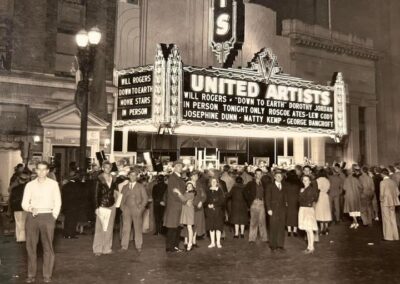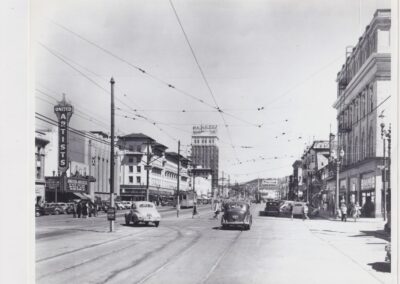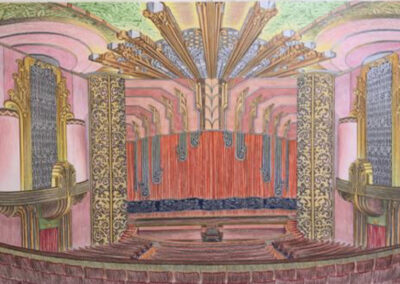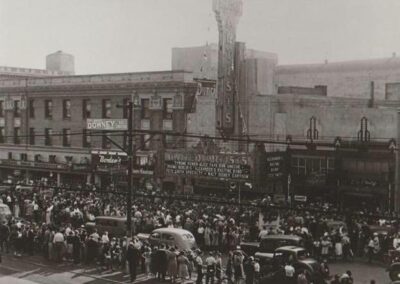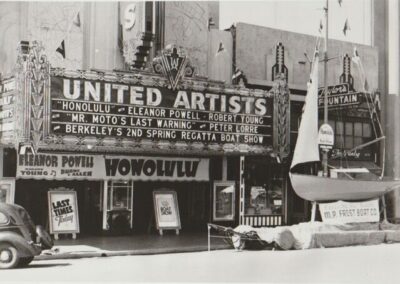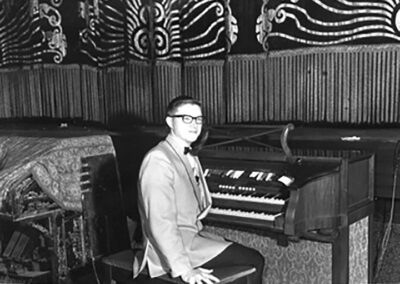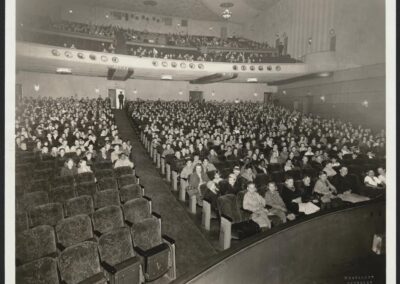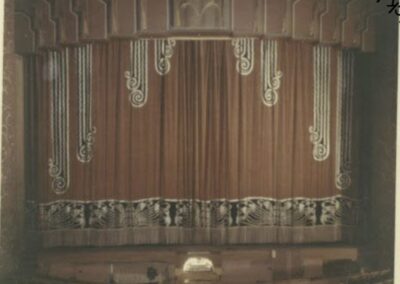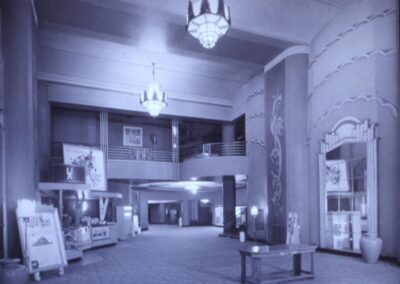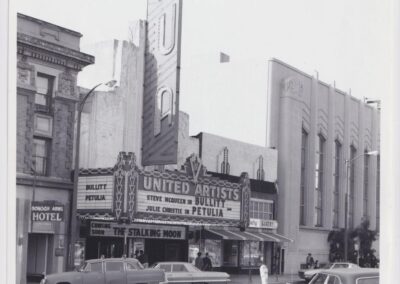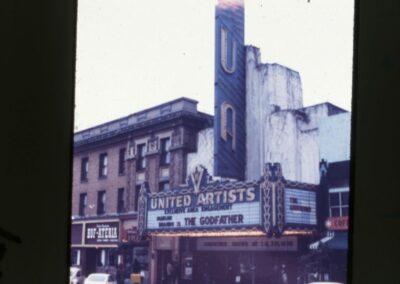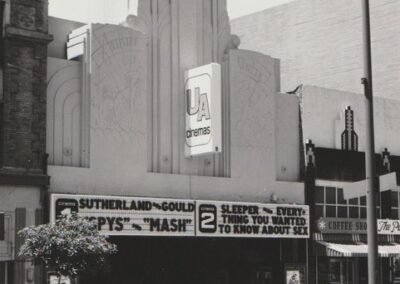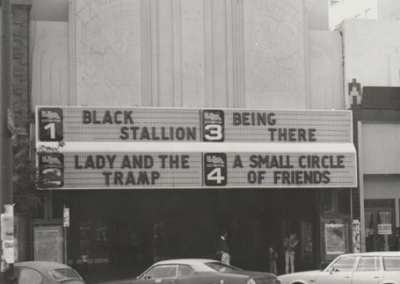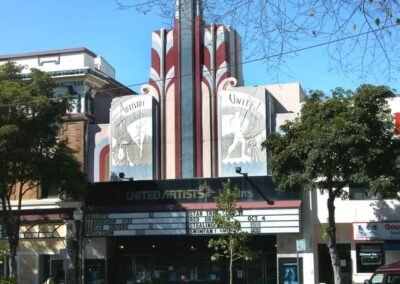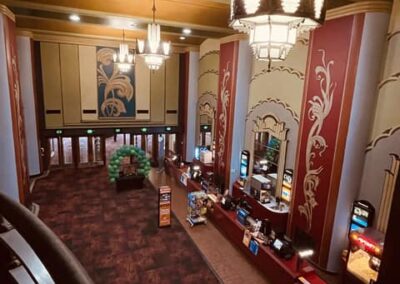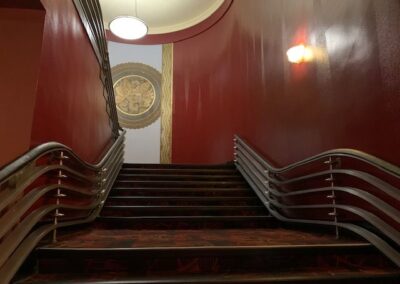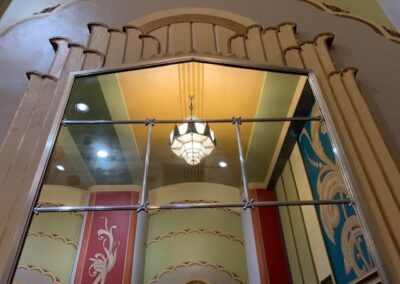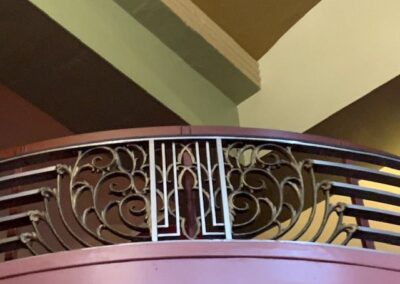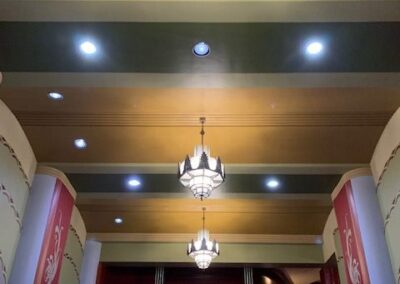Image Gallery
1940s Shattuck Ave with UA theater and Berkeley Public Library on the left. Credit: Steve Levin/Theatre Historical Society.
Artist rendering approximating original auditorium. Pillars, proscenium arch, and ceiling sunburst are believed to still exist in some form. Roslyn Manx, 2023.
Beautiful murals and painted ceiling designs by the renowned decorator Anthony Heinsbergen have adorned the theater since it opened in 1932.
Audience full of children extending to balcony showing various light fixtures and floral and striped patterns on walls, 1940s. Margaret Herrick Library.
UA in 1972, shortly before theater divided into two screens. Steve Levin/Theatre Historical Society.
Painted cast concrete facade with Unity and Artistry motif, 2002. WPA-style design includes musical instruments and a curving plume pattern on the tower above.
Lobby is four stories high with ornamental plasterwork, pillars, French mirrors, custom chandeliers, and original wood entrance doors with etched glass panels.
The polished aluminum bannisters made by an Emeryville firm still look modern today. Also pictured is Art Deco medallion design by acclaimed decorator Anthony Heinsbergen.
Large, beveled French mirror reflects the sculpted plasterwork designs and modernistic chandelier of the grand lobby.
1940s Shattuck Ave with UA theater and Berkeley Public Library on the left. Credit: Steve Levin/Theatre Historical Society.
Artist rendering approximating original auditorium. Pillars, proscenium arch, and ceiling sunburst are believed to still exist in some form. Roslyn Manx, 2023.
Beautiful murals and painted ceiling designs by the renowned decorator Anthony Heinsbergen have adorned the theater since it opened in 1932.
Audience full of children extending to balcony showing various light fixtures and floral and striped patterns on walls, 1940s. Margaret Herrick Library.
UA in 1972, shortly before theater divided into two screens. Steve Levin/Theatre Historical Society.
Painted cast concrete facade with Unity and Artistry motif, 2002. WPA-style design includes musical instruments and a curving plume pattern on the tower above.
Lobby is four stories high with ornamental plasterwork, pillars, French mirrors, custom chandeliers, and original wood entrance doors with etched glass panels.
The polished aluminum bannisters made by an Emeryville firm still look modern today. Also pictured is Art Deco medallion design by acclaimed decorator Anthony Heinsbergen.
Large, beveled French mirror reflects the sculpted plasterwork designs and modernistic chandelier of the grand lobby.
History of the theater
THE UA BERKELEY’S GLORIOUS PAST AND POTENTIAL FOR RENEWAL
When the United Artists theater opened on Shattuck Avenue on September 16, 1932, the event was so dazzling a newspaper ran a headline reminding locals this was “Not Hollywood, but Berkeley.”
“Talking picture” luminaries including Mary Pickford and Bing Crosby signed autographs under the giant marquee and soaring neon-lit tower while beaming klieg lights swept the night sky. The country was in the throes of the Great Depression, making the debut of this magnificent Art Deco theater even more spectacular to “stargazing” locals.
“Every one of the 1,800 luxurious seats in the theater was filled within five minutes after the doors opened,” the Berkeley Daily Gazette reported. “Twice as many filled the foyers, waiting for an opportunity to obtain seats for the second show.”
In fact, this was “the greatest theatrical event in the history of Berkeley,” the Gazette declared.
Among the throng of Berkeleyans were numerous local officials including city council members and Berkeley Mayor Thomas E. Caldecott. “Down to Earth” starring Will Rogers was the featured cinematic attraction. Uniformed ushers guided patrons to their “air cushioned” velvet seats.
The UA was part of a grouping of opulent, modern theaters built by the United Artists Corporation in the ‘20s and ‘30s, all of them in Southern California except for the one in Berkeley. The theater line was an offshoot of the film production and distribution company founded by movie icons Pickford, Charlie Chaplin, and Douglas Fairbanks, who sought more financial and creative control of their work.
Managed by Fox West Coast Theatres, the UA Berkeley was designed by architect Clifford Balch and the firm Walker & Eisen, with interior decor by the Heinsbergen Decorating Company of Los Angeles.
Ticket prices ranged from 30 to 69 cents for adults, and 10 cents for children. The theater cost roughly $300,000 to build, which today sounds like a bargain but make no mistake, this was a grand theater crafted by some 200 laborers and fitted with the best in Art Deco furnishings. The decorative splendor included chandeliers, murals, railings “like glistening silver,” large men’s and women’s lounges with luxe furniture, and Roman drinking fountains with sparkling ice water that were lauded as works of art.
“Hundreds stopped to congratulate Manager Clarence L. Laws on the beauty of the theater and the wonderful service rendered by house staff,” the Gazette wrote.
The theater was arguably even more breathtaking once entering the auditorium. Because the UA was originally designed as a live vaudeville venue, it was built with a stage 25-feet deep, numerous dressing rooms, a green room, “one of the greatest electric concert organs” in the state, and a spacious orchestra pit.
The Gazette raved about “the great stage with its artistic drapes,” the proscenium arch etched with angels, the “golden console” of the organ, the glowing sunburst design on the gilded ceiling, and the clusters of blue, green, yellow, and white lightbulbs illuminating from below the balcony rail.
WEATHERING CHANGES OVER ITS 91-YEAR HISTORY
Considering the UA Berkeley opened at a time when thousands of banks were failing and millions of American were out of work, it’s impressive that the theater remained open for 91 years. Over the decades the theater would endure multiple changes in ownership, modifications to its exterior, and multiplex conversions starting in the ‘70s.
In the late 1940s, the UA chain was acquired by San Francisco-based movie theater operators Robert and Marshall Naify. Under their ownership the chain swelled to more than 2,000 theaters, making it the largest chain in the U.S. In 1988, however, the Naifys sold the UA chain to a telecommunications company in Colorado. Some years later United Artists went bankrupt and was merged with other insolvent cinema companies under the Regal Entertainment Group, which is still operating today.
Due to changing aesthetic tastes in the mid-century, the original boxy lighted marquee that jutted far over Shattuck Avenue was nixed for something less imposing. Likewise, the towering neon sign was taken down for being too garish. What has remained is the painted cast concrete facade with the WPA-style motif of Unity and Artistry.
In 1973, with the movie business taking a downturn, the UA Berkeley was bisected into two screens, then partitioned into four screens two years later. By 1987 the UA was split into seven auditoriums, the configuration that lasted until its closure in 2023.


While city officials have neglected to designate the UA a local landmark, it was found eligible for the National Register of Historic Places in 1978. In 2006, it was placed on the California Register of Historical Resources.
Fortunately the UA Berkeley made it to 2023 with most of its distinct Art Deco decor and architectural elements intact, thanks to pressure at pivotal junctures over the years from local preservationists and architectural historians.
“I can say unequivocally that the United Artists Theater is an outstanding example of the Art Deco movie palace which is fast vanishing from the urban landscape and is so prized by moviegoers all across the country,” wrote architectural consultant and author Mark A. Wilson in 1982.
Even the major elements of the original 1,800-seat auditorium, such as the stage and ceiling, are known to exist behind the partitions. This is why local preservationists and theater experts believe the UA Berkeley is a prime candidate for renewal—if it is not destroyed for the proposed apartment tower that is on the fast track to approval with the city. The developer, Panoramic Interests, purchased the property in 2022.
What is most in need of being restored is the reputation of the UA Berkeley. Because it was converted to multiple screens starting 50 years ago, most people today aren’t familiar with the UA’s original grandeur. Save the UA Berkeley’s primary goal is raising awareness about the theater’s glorious past, its immense architectural value and its potential to be reborn as venue with a range of offerings including live music, theater, musicals, dance, speaking events, and private parties.
And perhaps movies, too.
If the UA can be saved, the potential is limitless.

